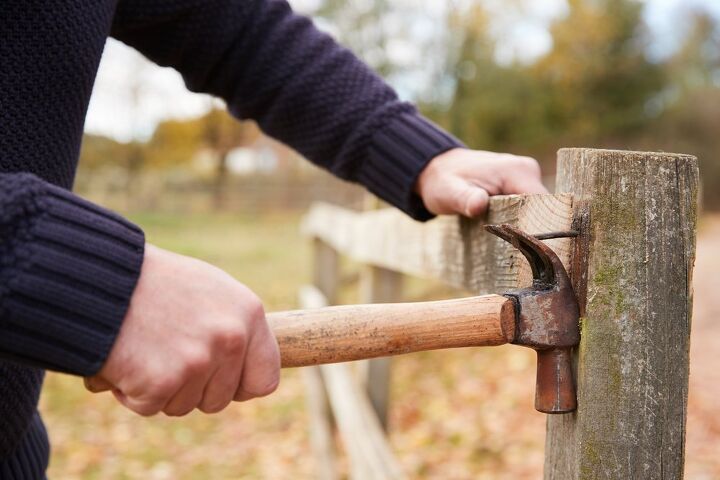Can My Neighbor Remove A Boundary Fence?

They say good fences make great neighbors. But what happens when fencing becomes the source of a dispute? Can a neighbor remove your boundary fence without permission? And what can you do if they violate your property lines? Here’s everything you need to know.
The neighbors don’t have the right to tamper with your private property. So, they can’t remove boundary fencing even if they don’t like its location. Neighbors must take you to court to dispute the fence placement. Or they can argue that your structure encroaches on their land. Either way, don’t let people touch or move your stuff without consent.
Do You Need to Hire A Land Surveyor?
Get free, zero-commitment quotes from pro contractors near you.

Who Owns a Boundary Fence?
The boundary fence around your property belongs to the person who built it. So, the homeowner is usually responsible for its location and upkeep. However, those rules might differ for rental estates, public areas, or government buildings. And you have to check local records to determine the owner in those cases.
If you have questions about who owns the boundary fencing in your yard, you can also ask the neighbors. Or see if your landlord can give you more information. Either way, don’t tamper with a property barrier until you establish the rightful owner. That’s because you could get in trouble for vandalism or trespassing if you’re not careful.
How Do You Know Whose Fence Is Whose?
You can determine whose fence is whose by looking at the property line. If the structure is on your side of the line, it belongs to you. But if it rests in your neighbor’s yard, it’s their responsibility. Meanwhile, find property lines like this:
- Visit the County Courthouse. Go to the Assessor or Recorder’s office. There, you can access public records regarding your whole street.
- Go Online to See Measurements. Some counties offer online views of property lines so you can see where things fall.
- Ask Your Landlord. See if they have any documents about legal borders between your yard and the neighbors’. Or look at your lease for more details.
- Consult the Seller. Find out what the previous owners know about your lawn. Then, gather documents to back up their claims.
Once you establish the borders, you can hang no trespassing signs to prevent unauthorized entry. So, record your domain at the local courthouse. That way, you can sue nasty neighbors who try to tamper with your stuff.
What Are the Rules on Boundary Fences?
Every city has different rules regarding fences. And you can’t always knock down or move existing structures even if you own them. So, be sure to check your local laws for more information. Then, keep detailed records of every decision you make.
In general, you should always build boundary fences with the panels facing outward along the border. That placement gives your lawn a sleek appearance and better curb appeal. But remember that fence posts should remain on your side of the property line. Your neighbors can remove fencing if it impedes their yard. And they can also sue you if you don’t take it down when they ask.
Rules about private fencing can vary from state to state. And some state laws may differ between counties. That means you have to determine the local mandates before doing anything. Then you have to find out if your neighbors have any rights to the existing structure.
In some states, the neighbors can claim your land if they prove you abandoned it. Plus, they can sue if your fence is too high. So, be sure to maintain the area around your property line. And make sure the fence height is allowed in your neighborhood.
DID YOU KNOW: Some communities restrict the type of fencing you can use. So, do your research before erecting a new one.
How High Can a Fence Be?
Laws about boundary fences can change based on where you live. For example, most places say your structure can’t exceed a certain height. Usually, cities determine height limitations by the landscape and the traffic. But other factors can affect the rules as well.
In general, cities prohibit fencing that obstructs the view or slows traffic flow. You also can’t cause a nuisance with your fence or put the neighbors in danger. That means barriers that block entrances or hide street signs are illegal. However, illegal fencing doesn’t give people the right to remove it without notice. They must follow the appropriate channels to get you to take it down.
Can My Neighbor Remove My Boundary Fence?
Your neighbor can’t tamper with your boundary fence unless they have a legal right to do so. Thus, they must show ownership of the property to remove fencing around it. The proof involves documentation of your property lines. And if the fence posts are on your side of the lawn, you can sue them for trespassing or vandalism.
The neighbors have to prove to the courts that your fence causes problems in the community. Then, the court can order you to move it, take it down, or find an alternative. Until then, people can’t tear up your property just because they don’t like it. They can confront you to negotiate or consult law enforcement instead.
What Can I Do If a Neighbor Removes My Boundary Fence?
You don’t have to stand by as your next-door neighbor ruins your fencing. That’s because you have rights as the homeowner. So, here are the five steps to take if someone tampers with your property:
- Check the Laws. Make sure your neighbor doesn’t have a right to mess with your stuff. And if they don’t, move to the next step.
- Confront Your Neighbor. Get proof or a confession to help you in court. Then, warn them to stay away from your property.
- Put It in Writing. Jot a thoughtful letter to your neighbor and keep a copy. You can use the correspondence as evidence in court.
- Collect the Evidence. Gather pictures and get testimonies from witnesses. But keep an organized file, so nothing gets lost.
- Contact the Police. You can call law enforcement about property line encroachments. And you can summon police as witnesses if your case goes to trial.
Organize your evidence and let the law decide. Or try to legally change the property lines if you can’t settle the dispute.
How Do You Legally Change Property Lines?
Ready to change the property lines around your house? Here’s how to do it:
Step One: Talk to Your Neighbor
Make sure they agree with the proposed boundary change. Try to be fair. And give the neighbors some logical reasons for the alteration. If they disagree, you can hire a lawyer to help convince them.
Step Two: Enter a Boundary Agreement
If your neighbor is willing, ask them to sign an agreement that establishes new property lines. You can use the contract in court because it’s legally binding. And the deal is good until someone changes it.
Step Three: File It In Court
Let the county Assessor or Recorder know about the new deal. They will update the public records as soon as possible. Then, you’ll receive notice in the mail confirming the change.
Whatever the case, try to avoid heated arguments with the neighbors. Boundary fences are supposed to help separate properties and eliminate disputes. So, work toward peaceful living by utilizing the legal system.
Do You Need to Hire A Land Surveyor?
Get free, zero-commitment quotes from pro contractors near you.

Related Questions
Who Is Responsible for Fixing a Fence?
The owner of the fence is always responsible for fixing it. But you can’t establish the owner unless you can define the property lines. So, look up public records to find out. And make sure your neighbors are maintaining their fences correctly. Otherwise, you can sue them for maintaining a common nuisance or endangering the community.
What Can I Do If My Neighbor Refuses to Fix Fencing?
You can do several things if a neighbor refuses to fix their broken fence. And you may have even more rights if their wall is supposed to provide protection from animals or dangerous objects. So, confront them first in person or writing. Then, give them time to make repairs. If they ignore your requests or neglect your lawful warnings, you can sue them in court. But hire a lawyer for more information.
How Close to a Property Line Can a Fence Be?
Each county has different laws regarding property lines and boundary fences. So, always check the local regulations first. But remember that you usually can’t put up fencing within eight inches of the road, sidewalk, or property line. And if you live in an urban area, the limitations on acceptable fencing could be even stricter.
No Fighting Over Fencing
Stop fussing with the neighbors over the boundary fence. Establish the property lines instead. Then, determine who’s responsible for its placement and upkeep. Or ask the court to help you change the parameters.
Related Guides

Tiffany Nichols specializes in aesthetics, design, marketing, and manufacturing. She's a copywriter and editor for several home renovation companies in the U.S. and works alongside some of the biggest names in the industry. Her hobbies include architecture, art, mental health, and fashion.
More by Tiffany Nichols



























